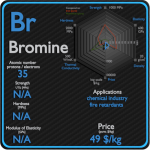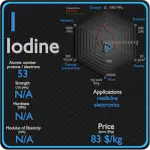This article contains comparison of key thermal and atomic properties of magnesium and bromine, two comparable chemical elements from the periodic table. It also contains basic descriptions and applications of both elements. Magnesium vs Bromine.

Magnesium and Bromine – About Elements


Source: www.luciteria.com
Magnesium and Bromine – Applications
Magnesium
Magnesium is the third-most-commonly-used structural metal, following iron and aluminium.[35] The main applications of magnesium are, in order: aluminium alloys, die-casting (alloyed with zinc), removing sulfur in the production of iron and steel, and the production of titanium in the Kroll process. Magnesium alloys are used in a wide variety of structural and nonstructural applications. Structural applications include automotive, industrial, materials-handling, commercial, and aerospace equipment. Magnesium alloys are used for parts that operate at high speeds and thus must be light weight to minimize inertial forces. Commercial applications include hand-held tools, laptops, luggage, and ladders, automobiles (e.g., steering wheels and columns, seat frames, transmission cases). Magnox (alloy), whose name is an abbreviation for “magnesium non-oxidizing”, is 99% magnesium and 1% aluminum, and is used in the cladding of fuel rods in magnox nuclear power reactors.
Bromine
A wide variety of organobromine compounds are used in industry. Some are prepared from bromine and others are prepared from hydrogen bromide, which is obtained by burning hydrogen in bromine. Brominated flame retardants represent a commodity of growing importance, and make up the largest commercial use of bromine. One of the major uses of bromine is a water purifier/disinfectant, as an alternative to chlorine. Bromine compounds are effective pesticides, used both as soil fumigants in agriculture, particularly fruit-growing, and as a fumigant to prevent pests from attacking stored grain and other produce.
Magnesium and Bromine – Comparison in Table
| Element | Magnesium | Bromine |
| Density | 1.738 g/cm3 | 3.12 g/cm3 |
| Ultimate Tensile Strength | 200 MPa | N/A |
| Yield Strength | N/A | N/A |
| Young’s Modulus of Elasticity | 45 GPa | N/A |
| Mohs Scale | 2.5 | N/A |
| Brinell Hardness | 260 MPa | N/A |
| Vickers Hardness | N/A | N/A |
| Melting Point | 649 °C | -7.3 °C |
| Boiling Point | 1090 °C | 59 °C |
| Thermal Conductivity | 156 W/mK | 0.122 W/mK |
| Thermal Expansion Coefficient | 24.8 µm/mK | N/A |
| Specific Heat | 1.02 J/g K | 0.473 J/g K |
| Heat of Fusion | 8.954 kJ/mol | 5.286 kJ/mol |
| Heat of Vaporization | 127.4 kJ/mol | 15.438 kJ/mol |














